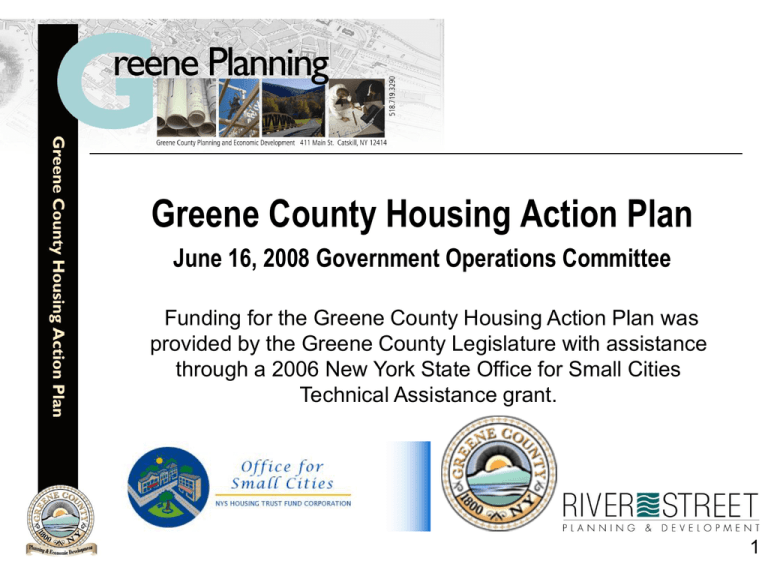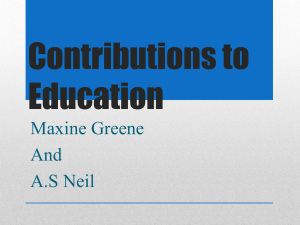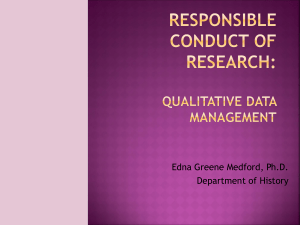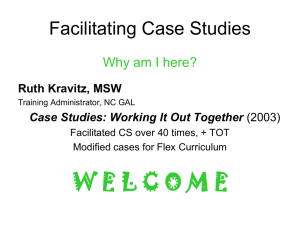Greene County Housing Action Plan Powerpoint
advertisement

Greene County Housing Action Plan June 16, 2008 Government Operations Committee Funding for the Greene County Housing Action Plan was provided by the Greene County Legislature with assistance through a 2006 New York State Office for Small Cities Technical Assistance grant. 1 Advisory Committee Members Karen Deyo – Greene County Legislature Government Operations Committee Chairperson Keith W. Valentine – Greene County Legislature Majority Leader Larry Gardner – Greene County Legislature Minority Leader Larry Krajeski – Executive Director, Catskill Mountain Housing Development Corporation Charlene Holdridge – Executive Director, Hunter Foundation Trisha Lamb – VP & Mortgage Officer – The Bank of Greene County Mark Hyer – Chairman, Town of Hunter Planning Board Charlie Maggio – Housing Developer Thomas Yandeau – Director, Greene County Department of the Aging 2 Components of the Housing Action Plan An examination of housing needs in Greene County. Examine the potential tenant and homebuyer demand for various housing options. Explaining the components of a healthy housing mix. Providing the County and local decision makers with implementation steps to address housing needs in Greene County. Providing assistance and examples to local municipalities on the creation of appropriate land use regulations. Provide local municipalities with tools to make effective decisions regarding housing developments. 3 Why a Balanced Housing Market is Good for Greene County Builds Strong Communities: A balanced housing market promotes healthy and livable communities and preserves property values by encouraging responsible land use and the development of a variety of housing types. Attracts and Retains Jobs: Housing choices allows workers, such as firefighters, policeman, correction officers, teachers, and nurses to live in the communities they serve. A variety of housing options are important to meet the needs of workers in high, moderate and low wage jobs. A variety of housing options also helps businesses hire and retain employees. The availability of a range of quality and affordable housing is also a critical factor in successfully attracting new businesses to Greene County. 4 Why a Balanced Housing Market is Good for Greene County (cont’d) Let’s Working Families and Seniors Stay in the Towns they Call Home. - Younger Residents: Younger residents need affordable housing to remain in the County supporting our workforce labor needs. They also bring an energetic vibrancy that helps revitalization efforts. - Senior Residents: Seniors contribute to the sense of history of the community and are important sources of volunteer service and labor. Affordable housing allows senior residents to age in place, keeping grandparents living near their children and grandchildren. 5 Key Reasons Why Greene County Created a Plan The County has experienced housing prices that have increased higher than median incomes since 2000. The County’s current housing prices are more than three times the County’s median family income, with most units not being affordable to current residents according to generally accepted standards of affordability. In 1999, the median housing price in Greene County was less than twice the median family income. Unaffordable housing makes it more difficult for the County to attract and maintain the workforce it needs to continue to develop and grow. 6 Why a Housing Action Plan for Greene County Greene County’s Housing Action Plan addresses all phases of a family’s life cycle for our residents: – Young couples buying a starter house. Retaining young people in the County is critical to maintaining our workforce. – “Move-Up” purchases to houses large enough for a family. – Workforce housing that provides housing for working residents in the County. – Housing that provides a variety of post-children and retirement options. – Renters that need housing, but either do not have the income or interest in purchasing housing. 7 Greene County’s Dramatic Increase in Housing Prices Median selling price of homes in Greene County have increased 122.8% ($78,313 to $174,500) from 2000 to 2006. (Source: Economic Report of the Hudson Valley Annual 2006 by Marist College) Median family income increased only 31.5% during the same period from $42,200 in 2000 to $55,500 in 2007. (Source: U.S Department of Housing and Urban Development) Between 2002 and 2006, Greene County experienced the highest percentage change in average housing values among the nine counties located in the Hudson Valley. (Source: Pattern for Progress – December 10, 2007 Report) 8 Greene County Median Housing Prices by Sub-Region Average 2007 asking price for Greene County homes by subregion (Columbia-Greene Board of Realtors) – Historic River Towns is $195,223 – Valley Towns is $170,927 – Mountaintop Towns is $300,113 Median price of homes sold in 2007 (Greene County Real Property Tax Services): – Historic River Towns is $167,408 – Valley Towns is $160,000 – Mountaintop Towns is $222,500 9 Greene County Income Distribution 46% of residents are below 80% of Greene County median income. (Below $44,400 for a family of four in 2008) 21% of residents are between 80% to 120% of Greene County median income. 33% of residents are above 120% of Greene County Median Income. 33% 46% 21% The fastest-growing sector of the population in the County is below 80% of median income. Source: 2000 Census and HUD Income Limits. Compilation of Household income statistics was prepared by River Street Planning & Development, LLC. 11 Greene County Continues to Grow in Population Since 2000, Greene County has grown 2.2% in population from 48,195 to 49,246. Greene County anticipates further growth in population in the 2010 Census. Greene County continues to witness an influx of new residents each year, particularly from the New York City metropolitan area and lower Hudson Valley. The County’s median age is 39, and rising as the population ages both in New York State and nationally. 12 Greene County is a Magnet for Downstaters Between the 2000-2001 and 2005-2006 tax years, a total of 2,739 Hudson Valley and New York City residents moved to Greene County based on IRS data compiled by Marist College, representing 40% of all new residents moving to the County. Former Hudson Valley and NYC residents have higher median incomes in comparison to Greene County residents and are able to spend more on housing costs. In Greene County, housing is more affordable in comparison to the Lower Hudson Valley and points south. The people who move into Greene County are also allowing the county population to grow. Greene County has more deaths than births, and without the migration from other areas Greene County would decrease in population. 15 River Towns Average Family Case Study A corrections officer living in one of the River Towns with a household income of $43,220 would be able to afford to buy a house in the $110,000-120,000 range, based on typical lending standards of 30% of income to mortgage, 20% down and having a monthly payment of about $1,300. The average asking price for a home in the River Towns was $195,223 in 2007. The mortgage on a house in this price range would be about $1,900. The $600 per month gap is $7,200 in annual income. 16 River Town Community Case Study Slides Source: Greene County Multiple Listing Service Asking Price $112,900 Asking Price $119,000 Asking Price $120,000 17 Valley Town Typical Family Case Study A two-income household living in a Valley Town (teacher and local government employee) with a combined household income of $57,036 would be able to afford to buy a house in the $150,000 to $160,000 range, with a monthly payment of about $1,425. The average asking price for a home in the Valley Towns was $170,927 in 2007, so the average monthly payment would be about $1,600. The Valley Towns are the fastest-growing sub-region in the County. 18 Valley Town Community Case Study Slides Asking Price $155,000 Asking Price $159,500 Asking Price $ 159,900 Source: Greene County Multiple Listing Service 19 Mountaintop Affordability Case Study A two-person household living in one of the Mountaintop Towns (insurance and retail employee) with an average household income of $60,702 would be able to afford to buy a house in the $160,000 to $170,000 range, with a monthly payment of about $1,550. The average asking price for a home in the Mountaintop Towns was $300,113 in 2007, with a monthly payment of about $2,500 with 20% down. The gap in payment is about $12,000 in annual income. The Mountaintop region has approximately 75% homeownership from out-of-County residents. 20 Mountaintop Community Case Study Slides Asking Price $160,000 Asking Price $164,000 Asking Price $169,000 Source: Greene County Multiple Listing Service 21 Key Findings of Case Study Analysis Housing prices rose rapidly throughout the County during the decade of the 2000’s, both due to the internal market and external demand. Housing prices have risen much more rapidly than wages, turning Greene County from a very affordable housing community to one struggling with affordability issues for its residents. People earning the median income in Greene County can afford modest homes in the current market. People earning less are likely locked out of the housing market without subsidies. 22 Why Communities Need Rental Housing Communities are diverse and people living here have different needs at any given time. Not all households can afford to purchase a home, while others may not want to undertake the burden of homeownership or may want to “try the community before buying in the community.” Quality affordable rental housing provides families with another option to meet their housing needs. Approximately 28% of occupied housing in the County is renter-occupied, according to the 2000 Census. The median gross rent for Greene County in 2000 was $508 for all bedroom sizes. The current median rent is almost $800. 23 Greene County Fair Market Rents A recent survey of rental listing found that the current average rents are higher than the Fair Market Rents, which is a gross rent estimate (shelter rent plus the cost of all tenant-paid utilities, except telephones, cable or satellite television service, and internet service) calculated annually by the U.S. Department of Housing & Urban Development (HUD) based on the 40th percentile of the market. (Source: The Daily Mail. August 27, 2007.) Greene County Fair Market Rents by Bedroom Size, 2008 Zero Bedroom One Bedroom Two Bedroom Three Bedroom Four Bedroom $582 $629 $766 $996 $1085 Source: U.S. Department of Housing & Urban Development 24 Fair Market Rent Changes and Analysis Greene County received an increase in its Fair Market Rent of over $100 per unit from HUD in 2008 to better reflect costs in the marketplace. Even with that increase, Fair Market Rents for many apartments in the County are below the market rents, as shown below: Difference between FMR and Average Rent One Bedroom Two Bedroom Three Bedroom Four Bedroom + $40 -$91 $0 -$90 25 Rental Market Case Studies In order to afford the average one-bedroom rent of $584, a person would need to make at least $11.23 per hour, or $23,360 per year, based on the generally accepted 30% of your income going to rent and working 40 hours a week. If you earn minimum wage ($7.15 an hour in New York State), then a person will have to work 63 hours per week to have an income high enough to afford the Greene County median onebedroom apartment rent. Greene County’s median wage is just over $15 per hour for all jobs, and many sectors average less than that. 26 Market Analysis: Rental Market In order to afford the average two-bedroom rent of $857, a person would need to make at least $16.48 per hour, or $34,280 per year, based on the generally accepted 30% of your income on rent (the generally accepted standard of affordability). If a person earns minimum wage ($7.15 an hour in New York State), then you will have to work 93 hours per week to have an income high enough the rent. Greene County’s median wage is just over $32,000 per year. 27 Focus Group Meeting A focus group meeting with Greene County stakeholders was held in September 2007 to discuss housing issues facing County residents. Invited stakeholders represented not-for-profit agencies and housing organizations, County Agencies, and Businesses and Developers. Comments received from stakeholders were used in the preparation of the Greene County Housing Action Plan. 28 Focus Group Meeting Notes Most service providers agreed that the County has a lack of affordable housing units. The County does not have shelters or apartments for persons who become homeless. Homeless people are being sheltered in hotels/motels and are having longer stays, increasing Social Services costs. Street rents have been higher than the HUD Fair Market Rent for some time. Apartments that are found to be affordable are often below HUD Housing Quality Standards and cannot be subsidized. There is an influx of new residents that are wealthier and are buying high end homes, renting luxury apartments, and spending money in the communities. Participants were aware of multi-family homes that were bought by newcomers and converted back to single-family, reducing the supply of housing while demand rises. 29 Focus Group Meeting Notes Most participants stated the need for a mix of housing in the County that serves all income levels. In the development of new housing, adequate infrastructure is critical. Potential affordable housing sites need to have water, sewer, natural gas and electric services available to reduce cost. Current costs of building residential units does not lend itself to providing low-income affordable rents (even with deep subsidies), especially when high-end rents are being paid by existing tenants. Reliable transportation to employment and needed services is becoming a huge obstacle for Greene County’s workforce population, especially as fuel costs continue to rise. Exclusionary zoning regulations are also an issue in finding sites to develop affordable housing. 30 Senior Housing in Greene County The Greene County Department for the Aging formed a shortterm housing committee to examine senior housing needs and report back to the County Legislature. Key findings include: There is strong demand for affordable housing for seniors, with waiting lists for senior apartments being one to two years. Seniors want to remain in their community, which is difficult in some cases as only six of the 14 Greene County towns have some form of subsidized senior housing. Seniors want independent living facilities, where service programs are needed, such as home delivered meals, personal care and housekeeping, in order to maintain as many seniors as possible in their homes. 31 Senior Housing in Greene County Proposed assisted living facilities will meet some of the housing needs of seniors. – Bristol Manor in New Baltimore has been approved for a loan by Greene County – will provide market rate assisted living housing. (Needs to be approved by Greene County DSS for beds). – Fairground Estates and Autumn Grove (below) shows typical senior housing in the County. Photos were taken by Catskill Mountain Housing Development Corporation 32 Housing Action Plan Results Development of a Detailed Housing Action Plan that: – Assesses barriers to development. – Identifies gaps in the market. – Provides detailed Goals, Strategies and Actions. Educational materials developed as part of the Plan include: – Fact Sheets for Local Officials, Planning Board members and the general public. – PowerPoint Presentation. – Community Cost of Services Analysis and Fiscal Impact Model. 34 County and Municipal Roles in Housing Action Plan Implementation The County has prepared the Housing Action Plan both to create policy for the County and its agencies to follow regarding housing, but also to work with local municipalities on effective ways to meet their housing needs. - County staff will also be providing technical assistance and meeting with local municipalities to explain and assist them with housing related issues. 35 Housing Action Plan Goals Goal One: Provide an ample supply of housing for all phases of a family’s life cycle - enabling young couples to rent or buy a starter home, eventually move up into a home large enough for a family and housing that provides a variety of post-children and retirement options. Goal Two: Continue to work with the Department for the Aging on implementing their recommendations from the Senior Housing Study. Goal Three: Mitigate or eliminate barriers to affordable and workforce housing initiatives through a program of public education and support advocacy. 36 Housing Action Plan Goals (cont’d) Goal Four: Encourage Greene County municipalities to adopt land management tools that create opportunities for affordable and workforce housing. Goal Five: Continue to expand or improve infrastructure to facilitate more adequate housing. 37 Goal One and Related Strategies Provide an ample supply of housing for all phases of a family’s life cycle - enabling young couples to rent or buy a starter home, eventually move up into a home large enough for a family and housing that provides a variety of post-children and retirement options. Strategy 1: Identify and improve residential development within the village and town centers. Strategy 2: Continue to encourage the development of mixed income home purchase and rental projects. Strategy 3: In partnership with county organizations and non-profit housing organizations, promote housing rehabilitation and homeownership programs. Strategy 4: Encourage employer-sponsored worker housing initiatives. 38 Goal Two and Related Strategies Continue to work with the Department for the Aging on implementing their recommendations from the Senior Housing Study. Strategy 1: Identify specific senior housing developments that will assist with the increasing senior population in Greene County. Strategy 2: Provide opportunities for seniors to continue to age in place. 39 Goal Three and Related Strategies Mitigate or eliminate barriers to affordable and workforce housing initiatives through a program of public education and support advocacy. Strategy 1: Provide assistance to local municipalities to mitigate and eliminate barriers for housing. Strategy 2: Undertake a public education campaign to raise public official and citizen awareness about the importance of housing choice and representing a complete life-cycle of housing. 40 Goal Four and Related Strategies Encourage Greene County municipalities to adopt land management tools that create opportunities for affordable and workforce housing. Strategy 1: Encourage municipalities to adopt sound development principles. 41 Goal Five and Related Strategies Continue to expand or improve infrastructure to facilitate more adequate housing. Strategy 1: Continue to work with local municipalities with public facilities expansions. 42 Next Steps for Housing Action Plan The Housing Action Plan will be offered to the Greene County Legislature for adoption in July of 2008. Greene County Department of Planning and Economic Development will: - Provide local government with technical assistance on housing issues. - Present the Housing Action Plan to Town Boards. - Package and disseminate key plan information to the Towns, such as the Cost of Community Services and Fiscal Impact Analysis. 43 Next Steps for Housing Action Plan Greene County Department of Planning and Economic Development will encourage the local municipalities to: - Understand affordable housing issues in their community. - Update or adopt their comprehensive plans. - Work with the County to identify developable properties for housing. - Work with the County and other appropriate agencies to develop and improve infrastructure. 44 For Additional Information: Warren Hart, AICP, Director Karl Heck, AICP, Community Development Specialist Greene County Department of Planning and Economic Development (518) 719-3290 www.greeneplanning.com The Housing Fact Sheets and Full Housing Action Plan Report is available on the website shown above. 45







